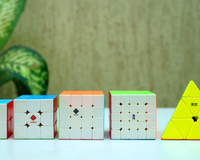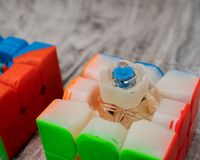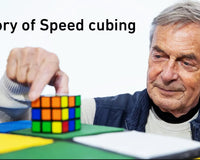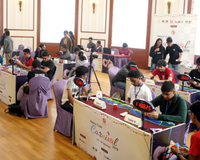The CFOP method is the fastest and most widely used speedcubing method in the world.
It breaks the solve into four stages — Cross, F2L, OLL, and PLL — and allows cubers to finish a 3×3 in under 10 seconds once mastered. Beginners can start with simplified versions, while advanced solvers learn up to 78 algorithms to increase speed. If you want to move from casual solving to real speedcubing, CFOP is the method you should learn.
Quick Summary
| CFOP Step | Meaning | What You Need to Learn |
| Cross | Solve a + on the first layer | Efficiency + lookahead |
| F2L | Pair corner + edge pieces | Intuitive → algorithmic |
| OLL | Orient last-layer stickers | 2-Look (10 algs) → Full (57 algs) |
| PLL | Permute last-layer pieces | 2-Look (6 algs) → Full (21 algs) |
Total full CFOP = 78 algorithms, but you can start with just 20–25 and still get fast.
What is CFOP?
CFOP stands for:
- Cross
- F2L (First 2 Layers)
- OLL (Orientation of the Last Layer)
- PLL (Permutation of the Last Layer).

CFOP is widely considered the fastest and most optimized solving method, and while it may seem scary at first, breaking it down step by step makes it manageable, even for beginners.
Step 1: The Cross - Your Foundation
The goal is to place the four edge pieces around the centre to form a cross, typically on the white face.

Tip to improve:
- Try to solve it in 8 moves or fewer.
- Reduce cube rotations
-
Look ahead:
Plan your cross during inspection
-
Try solving the cross on the bottom instead of on the top.
With practice, the cross becomes a 1–2 second step.
Step 2: F2L (First Two Layers)
Instead of solving:
-
First layer corners → and then
-
Second layer edges
…you pair them as corner + edge and insert them together.
This saves dozens of moves compared to beginner methods.
Instead of solving the corners and edges separately like in the beginner’s method, F2L pairs them up and inserts them at the same time. This is where CFOP really starts to speed up compared to layer-by-layer methods.

How to get better:
- Start with intuitive F2L — no algorithms needed initially
- Reduce cube rotations: your goal is to minimize unnecessary movements
- Learn advanced F2L cases one at a time
- Focus on lookahead (the real secret to speed)
- Once comfortable, learn algorithmic F2L for tricky cases.
F2L alone can cut your solves from 40 seconds → 20 seconds.
Step 3: OLL (Orientation of the Last Layer)
Now that the first two layers are done, it’s time to orient the last layer so that all the top stickers are the same color.

Two approaches:
-
2-Look OLL:
-
3–4 algorithms to make a cross
-
7 algorithms to orient the rest.
-
- Full OLL:
-
-
57 algorithms
-
Solves the entire last layer orientation in one step
-
Start with the 2-Look OLL and learn the full OLL gradually as you improve.
Step 4: PLL (Permutation of the Last Layer)
PLL fixes the last layer positions, completing the cube.

Learning PLL efficiently:
✔ 2-Look PLL (Beginner)
-
2 corner algorithms
-
4 edge algorithms
6 algorithms total
This is a good stepping stone.
✔ Full PLL
- 21 algorithms
- Solves the last layer in one step.
A must for serious speedcubers.
Full PLL + Full OLL → Last layer solved in two moves.
This is what takes cubers to sub-15 and sub-10 solves.
Taking CFOP to the Next Level
If you already know basic CFOP, here’s how to get faster:
1. Lookahead
Speedcubing isn’t just about turning fast; it’s about planning ahead. Train yourself to spot F2L pairs while finishing the cross, and recognize OLL and PLL patterns before finishing F2L.
2. Finger Tricks
Efficient turning is key. Learn how to execute algorithms quickly by trying out multiple different algorithms for a certain case and choosing one that fits your turning style.
Is CFOP Right for You?
CFOP is the dominant method in speedcubing, but it’s not the only one. Some cubers prefer Roux or ZZ for their unique solving styles. However, if you’re looking for the method with the most resources, tutorials, and world records behind it, CFOP is the way to go.
Now go grab your cube and start practicing!
Happy cubing!
































